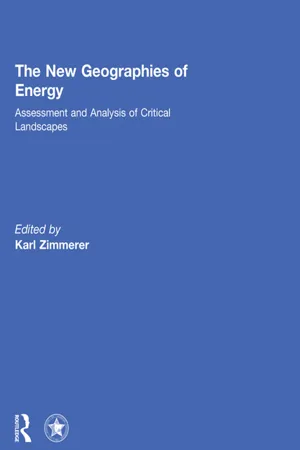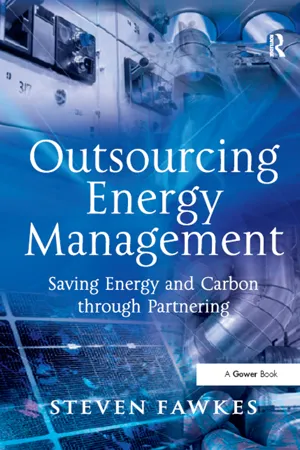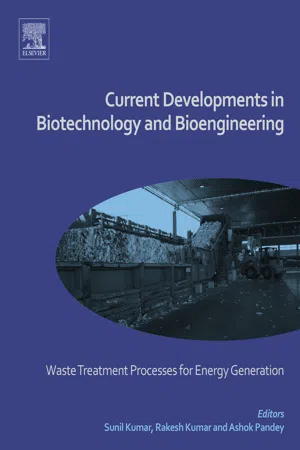Geography
Energy Management
Energy management involves the efficient use and conservation of energy resources to meet human needs while minimizing environmental impact. It encompasses strategies for optimizing energy production, distribution, and consumption, as well as promoting renewable energy sources and reducing energy waste. Effective energy management is crucial for sustainable development and addressing global energy challenges.
Written by Perlego with AI-assistance
Related key terms
4 Key excerpts on "Energy Management"
- eBook - ePub
- Mirjana Radovanovic, Stevan Popov, Sinisa Dodic(Authors)
- 2012(Publication Date)
- Academic Press(Publisher)
Energy Management is a particularly demanding challenge in all areas, especially in terms of the need to manage energy in a manner required by the modern world, which is not a simple application of the process of management in the field of energy. With the increasing intensity of energy use in the world, there has been a need to develop adequate Energy Management at all levels, where it is necessary to develop mechanisms that will react and adapt the whole process of management, depending on the character and intensity of changes taking place in the environment.The process of Energy Management can be seen in an extremely simplified way as a process that takes place from the moment of extraction of energy raw material to its final consumption and disposal of the waste energy. This process takes place in an extremely complex environment, is subject to the impact of numerous factors, and represents certain challenges in countries and regions where very stable conditions prevail and parameter changes are reduced to minimum. A particular problem is power management in the areas where frequent changes occur regarding type and intensity. Moreover, particularly challenging is the attempt to develop a unique model for Energy Management globally.With the introduction of the principle of sustainability, as the only principle of the development of mankind in the future, the issues of Energy Management are given a new dimension, which greatly differs from traditional management and imposes the need for the adoption of new solutions. In the most widely accepted context, Energy Management involves the use of a sustainable model of strategic management in the field of monitoring of energy flows in terms of production, transport, transformation, and consumption.Given the complexity of Energy Management, it is necessary to use the available approaches and modify them in accordance with the requirements of sustainability. Creating an adequate model of sustainable Energy Management is only possible with the integration of sustainable development requirements, particularities of the energy sector, and the science of strategic management. By integrating these criteria a new interdisciplinary approach to Energy Management has been created that has its own characteristics and is subject to changes depending on many factors. Therefore, it is primarily necessary to give a brief overview of the development of the science of strategy and strategic management in general. - eBook - ePub
The New Geographies of Energy
Assessment and Analysis of Critical Landscapes
- Karl Zimmerer(Author)
- 2013(Publication Date)
- Routledge(Publisher)
Similarly the all-around intensified relevance of energy issues puts into high relief a multitude of close-knit interactions with such topics as the geographies of peace, conflict, and political mobilization, as well as those of climate change (Kobayashi 2009; Aspinall 2010; see also Johnson 2010; North 2010; Rice 2010). Energy topics traverse broad social-environmental spectra of concerns and challenges; within contemporary geographic research these topics offer the promise of strengthening a core focus on the human-environment interactions and nature-society relations of industry (Huber 2010). Energy-fueled competition over resources and impacts on their quantity and quality—water in particular—is escalating over vast swaths of ecosystems and landscapes worldwide. Other growing interactions and dimensions of energy that are particularly well-suited topics of geographic research include the relations or linkages to overall socioeconomic development, urbanization, health and disease, and food and agriculture (to name only a few). The probing consideration of these issues is subject to a productive legacy of analysis and ideas over the past several decades (e.g., Harte and Jassby 1978; Knight 1989; Solomon and Karthik 2011).Conclusions
The chapters in this volume cover an ample range of geographic research topics, approaches, and contributions related to the new geographies and landscapes of global energy. These studies illustrate many of the principal geographic dimensions of energy emerging from multi-scale social-environmental influences and impacts embedded in dynamic landscapes of fossil fuels, renewable energy, and energy consumption. Specific contributions are concentrated in the following chief areas: (i) GIS modeling and assessment of energy flows—including an emphasis on carbon stocks and flows—with special interest and pronounced promise in footprint approaches, infrastructure (e.g., transportation, buildings), and industry- and household-level use; (ii) integrated social, political economic, and environmental analysis of oil and coal landscapes, with special emphasis on perspectives and concepts such as geopolitics, imperialism, peak oil, social justice, and resource-curse effects on development; (iii) original analysis of the renewable energy “alternatives” of biofuels, bioenergy, hydropower, and wind power, including detailed place-based examinations, that demonstrate the intricate interplay of potential productivity as well as limitations (typically the first three of these sources are held to have less scope for increase because of concerns over environmental resource impacts, while a combination of concerns also occur in the development of the nascent wind industry, as introduced above, as well as solar industry); and (iv) new geographies of energy networks (e.g., electricity regulation, generation, distribution, and use) and the thoroughly entwined socioeconomic-material nodes of energy consumption (e.g., energy poverty). A proliferating array of prime opportunities exist for continued and expanded geographic contributions in each of these principal areas, the several related and similarly compelling topics that are referred to only briefly above, and the numerous other dimensions of energy—all in urgent need of timely research and initiatives in geography and through geography’s myriad connections to interdisciplinary approaches. - eBook - ePub
Outsourcing Energy Management
Saving Energy and Carbon through Partnering
- Steven Fawkes(Author)
- 2017(Publication Date)
- Routledge(Publisher)
During the 1980s many organisations built capability and capacity in the Energy Management arena and many significant programmes were implemented across the economy with major results. During the 1990s, when competition in the energy supply markets resulted in lower energy prices, much of this capacity was eroded as companies downsized generally and in particular Energy Management specialists moved into energy procurement roles or other areas of activity altogether. Many organisations that previously had centralised Energy Management teams now have no specific organisation and energy is the part-time responsibility of an executive who has many other pressures.With increasing energy prices and increasing environmental pressures, there is now a need to rebuild Energy Management capacity within end-user companies, within energy service companies, and increasingly within energy suppliers. In addition Energy Management has grown beyond demand-side measures to include distributed, or embedded, supply side technologies such as CHP, renewables as well as biomass projects. There has also been an expansion into carbon management, which takes a holistic view of an organisation’s carbon emissions including those from transportation.This chapter sets out the basic activities that are essential to effective Energy Management and explains the most commonly used enabling tools. Over time, despite changes in available technologies, particularly in the metering and information arena, there has been a tendency for Energy Management to become fossilised. It is generally recognised in all economies there is a large gap between the identified economic potential for energy savings and the implemented potential (Sorrell, 2005). To help address that gap, energy demand management requires refocusing on the objective, that is achievement of the economic potential, and that this best done by a reframing and re-focusing of the Energy Management process. Often energy demand management does not deliver its full potential because one or more of the essential elements of effective energy demand management are not present or are diluted. This section presents a model of Energy Management that works to deliver maximum benefits and has been well proven in many different types of organisation. - eBook - ePub
Current Developments in Biotechnology and Bioengineering
Waste Treatment Processes for Energy Generation
- Sunil Kumar, Rakesh Kumar, Ashok Pandey(Authors)
- 2019(Publication Date)
- Elsevier(Publisher)
- 1. The technologies adapted in any field should be refined in such a way that maximum energy can be saved at the end of the process.
- 2. The techniques should be chosen such that they will enhance the efficiency of the process.
- 3. Energy should be saved and that energy may be used for further operations.
- 4. Renewable energy sources [16] should be implemented or may be compulsory wherever they can be easily adoptable.
- 5. GISs are able to do such mapping as may be helpful for utilizing the energy outputs.
- 6. GISs can be helpful in locating such advanced tools for utilization.
2. Applications of Geographic Information Systems in Energy Utilization
The salient features of GIS in energy utilization can be divided into following categories:- 2.1. spatial DBMS (SDBMS);
- 2.2. GIS for collection of waste, storage of waste, and transport route optimization;
- 2.3. GIS for site selection (based on location, site area, distance);
- 2.4. decision support system and multicriteria analysis;
- 2.5. GIS for energy distribution;
- 2.6. Web GIS (real-time monitoring).
2.1. Spatial Database Management Systems
Additional capabilities of handling spatial data are embedded in SDBMSs. Storing, modeling, and “querying the spatial data” (geographic data) are the key features of an SDBMS [17] . An SDBMS stores all the location details of WTE conversion sites and energy sources sites, and the distance between the plant and the source is also stored as spatial data. Along with the spatial data, the SDBMS can also store attribute data, i.e., name of the plant, amount of energy production, etc. The attribute data can be assigned to the spatial data wherever they are needed. One can monitor all the statistics related to a particular project.Storage of waste is one of the major steps involved in solid waste management. There are several factors that are considered for placing bins in the city:2.2. Geographic Information System for Collection of Waste, Storage of Waste, and Transport Route Optimization
2.2.1. Storage of Waste
Index pages curate the most relevant extracts from our library of academic textbooks. They’ve been created using an in-house natural language model (NLM), each adding context and meaning to key research topics.



